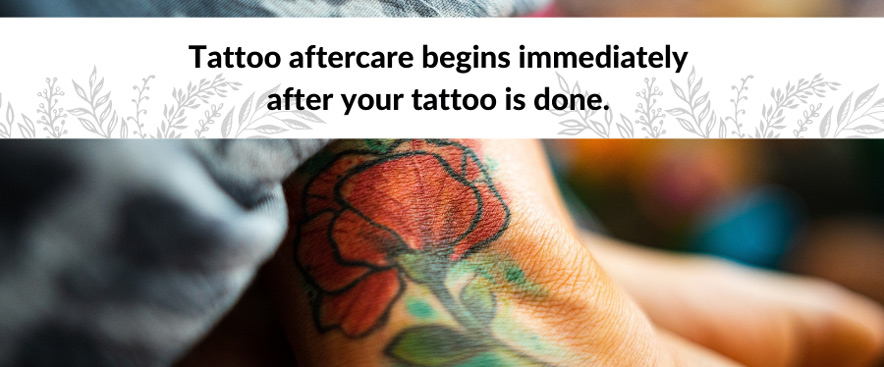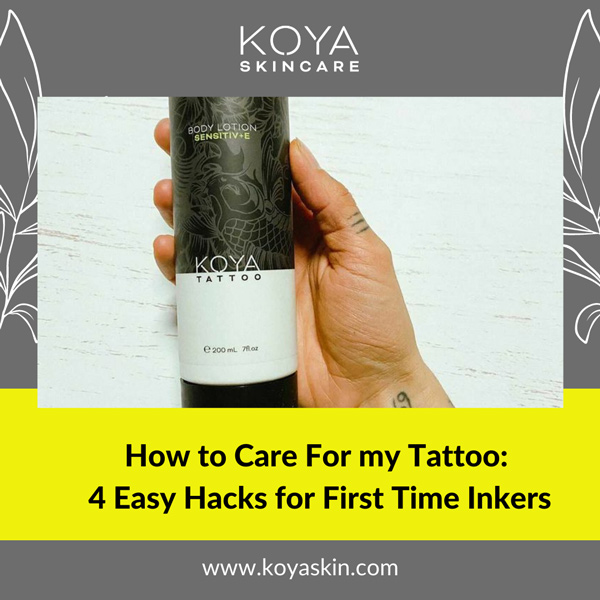
You finally did it!
You took a daring leap and got your first-ever tattoo.
And the results are epic. You just can’t get enough of it, and you even plan on getting another tattoo ASAP.
But here comes the elephant in the room—caring for your new tattoo.
As a first-time inker, caring for your tattoo is not as easy as you might think. You’ll have to take the proper care and precautions necessary for healing, lest your incredible work of art turn into a disappointing, faded mess.
However, most aftercare plans focus on just the first few days after tattooing. Sadly, this won’t sustain your tattoo’s vibrance.
Remember: Your tattoo is more than a piece of art; it’s a medical procedure and that means you’re vulnerable to infections and scarring.
Why does proper aftercare matter?
- To prevent medical complications: Poor aftercare can lead to serious skin infections like cellulitis.
- To keep your tattoo looking its best: Proper care will ensure your tattoo looks as good as it did when you first walked out of the studio.
- To support your skin during the healing process: KOYA Tattoo lotion, for instance, is packed with antioxidants (vitamin E, horsetail, and ginkgo biloba) that will hydrate and soothe your skin during the healing process.
- Proper care encourages good habits: Tattoo aftercare is a lifetime commitment—deeper skin layers can take up to 6 months to fully heal.
Tattoo aftercare begins immediately once your tattoo is complete. Your tattoo artist may advise you on caring for the new tattoo, but we’ve also gathered some extra tips to help you in your new journey.
Table of Contents
- Step 1 - Keep Your Tattoo Wrapped Up, but Only for a Few Hours
- Step 2 - Wash With Clean Lukewarm Water and Antibacterial Soap
- Step 3 - Apply the Right Amount of Moisturizer Regularly
- Step 4 - Be Patient With Your Healing Time
- Caring for Your New Tattoo: The DON’TS
- Tattoo Aftercare Has Never Been Easier
- Frequently Asked Questions
Step 1 - Keep Your Tattoo Wrapped Up, but Only for a Few Hours
Once you’re inked, your tattoo artist will apply an antibiotic ointment over the tattoo, then cover it with a bandage, plastic wrap, or cling film. The wrapping is done for many reasons:
- To prevent air from getting in or out of the tattoo area, keeping infection-causing bacteria away
- To protect the tattoo and wound as it heals and until a fresh layer of skin grows
- To prevent your clothes from rubbing against the print and causing irritations
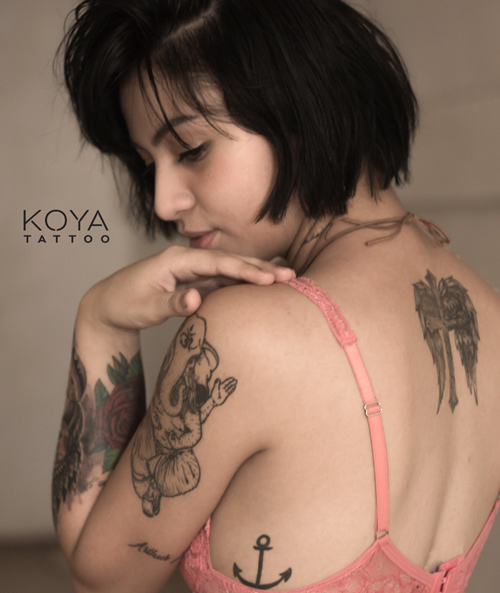
However, after a short while, you’ll need to remove the wrapping to allow your tattoo to completely heal. The tattoo needs air to heal, and covering it up for extended periods will prevent proper healing.
How long you’ll keep your tattoo covered depends on your artist’s instructions, its size, and location. Advice varies from studio to studio, but a general rule of thumb is to remove the wrapping after 2–4 hours.
That said, we recommend removing your tattoo bandage in the shower under running water. This helps loosen the adhesive and relax your skin, making the removal easy and comfortable.
Note: DO NOT re-bandageyour new tattoo since it needs to stay open to heal. If you wrap it back up, you're cutting off the oxygen supply and creating moisture, which will slow down the healing process.
Step 2 - Wash With Clean Lukewarm Water and Antibacterial Soap
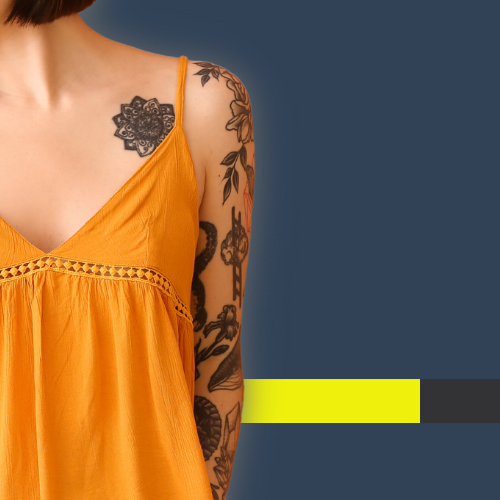
When it comes to a new ink, hygiene is key!
Ensure your tattoo is kept as clean as possible, just as you would care for a new piercing or wound.
Wash your hands with water and antibacterial soap before handling the tattoo to prevent the transfer of bacteria. Then gently wash the tattoo area using these 3 steps:
- Use unscented, antibacterial soap and lukewarm water to wash away plasma, blood, and excess ink. Refrain from using soaps with fragrances or alcohol as they can cause skin irritation, rashes, or itching.
- Avoid harsh scrubbing of the tattoo area, which can cause irritation and pull ink out of the skin, causing an uneven look after healing. Instead, use your finger pads in a circular motion to gently wash excess blood and plasma from the skin surface.
- Rinse your tattoo in warm water, then gently pat the skin dry. Don’t rub, since rubbing will pull at the skin and cause the ink to fall out.
Avoid using hot water to clean your tattoo at all costs! Hot water will open your pores and make the tattoo area vulnerable to bacteria or cause ink leakage.
Expert Tip: If your tattoo begins to peel or flake, don’t fret. Tattoo peeling is a normal part of the healing process and only happens during the first week.
Step 3 - Apply the Right Amount of Moisturizer Regularly
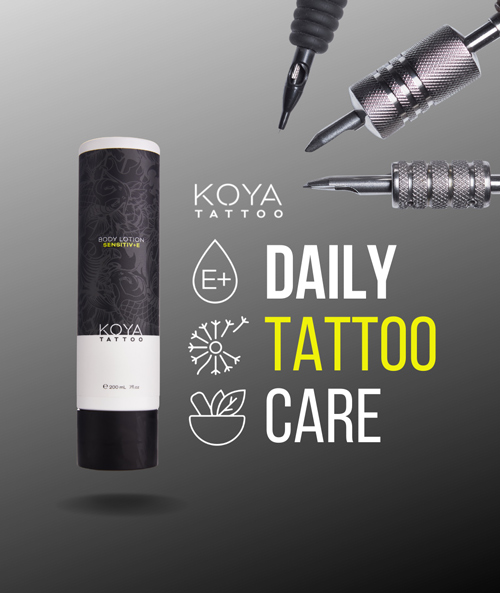
Keeping your tattoo hydrated and moisturized is an essential part of your aftercare routine. A good tattoo lotion has numerous benefits:
- It keeps your skin healthy and hydrated.
- It promotes the growth of new skin cells, leading to faster healing.
- It soothes inflamed skin, preventing itching and irritation.
- It prevents the tattoo area from cracking or drying out.
Without proper moisturizing, your tattoo will peel too much and this could mess up your design. The dryness may also lead to scratching, and this could result in an infection.
It’s, therefore, crucial to invest in a good moisturizer for your tattoo; one that’s made specifically for tattoos.
KOYA Tattoo is a gentle, fragrance-free daily tattoo moisturizer and aftercare lotion made with all-natural ingredients to boost your healing process and keep your tattoos looking fresh and protected. The moisturizer works perfectly for all skin types, including ultra-sensitive skin.
Read Also: A New Tattoo Care Brand......that’s Been Around for 10 Years
Packed with antioxidants like vitamin E, horsetail, and ginkgo biloba, KOYA Tattoo will leave your skin healed, visibly toned, and vibrant. Even better, the moisturizer has a light consistency, so you won’t experience the greasiness you get with thicker ointments.
"I tried KOYA Tattoo and it really gives a silky feeling without any of the sticky/greasy feeling. HIGHLY HIGHLY recommend."
— Bobby Brown, United States
When applying the KOYA Tattoo moisturizer, we recommend just a pea-sized amount of cream—a light layer enough to cover the tattoo area. Do this 2 or 3 times a day.
This prevents you from over-moisturizing your tattoo, which can lead to severe repercussions like tattoo inflammation, skin breakouts, and clogged pores.
Step 4 - Be Patient With Your Healing Time
It’s essential to practise patience after getting inked for a smooth healing process. A tattoo takes between 2 weeks and 6 months to completely heal.
The healing time depends on:
- The location of your tattoo: A tattoo located near a joint (e.g., ankle or wrist) will take longer to heal than in an area that doesn't move much.
- The size and complexity of your tattoo: Bigger and more complicated tattoos take longer to heal.
- Your body’s ability to recover: Some bodies take longer to heal than others.
It’s crucial to ensure your tattoo is healing properly. The following signs are an indication that your tattoo requires medical intervention.
| Sign | What It Means |
| Redness |
|
| Fever or Chills |
|
| Oozing liquid (Yellowish or Greenish) |
|
| Prolonged itching |
|
| Swollen, puffy skin |
|
Ensure you're consistent with your aftercare routine to keep your tattoo free from infection. If you notice any of these signs, contact your doctor immediately.
Caring for Your New Tattoo: The DON’TS
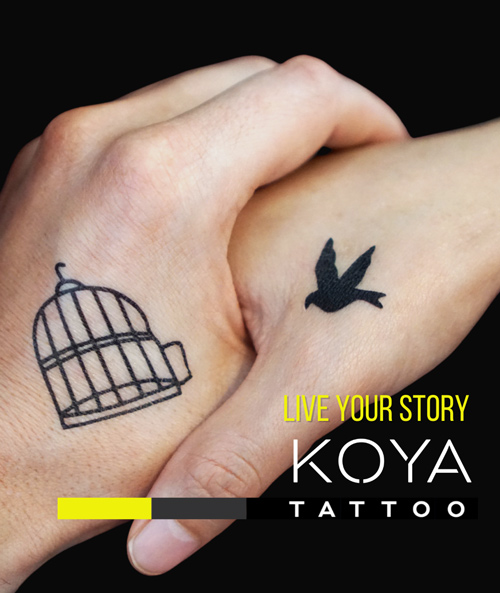
To keep your tattoo looking healthy and vivid:
- Don’t pick the scabs: As tempting as it may be to peel or scratch the scabs, don’t do it. At this point, your tattoo is still an open wound, and scratching it will only irritate your skin and make it vulnerable to infection. When it itches (and it will), apply the KOYA Tattoo lotion, gently slap it, or hold something cold against it.
- Don’t soak your tattoo under water for at least 3–4 weeks: Submerging your tattoo in standing water bodies, like pools and bathtubs, before it heals damages your ink and prolongs the healing process.
- Don’t wear tight clothes: Tight clothes prevent airflow to your tattoo, obstructing your healing process. They can also smudge the tattoo ink or pull against the healing scabs, causing infection.
- Don’t expose your tattoo to direct sunlight: Prolonged exposure to the sun’s UV rays can break up the tattoo’s pigment and slow down the healing process if you get a sunburn.
- Don’t use a rough towel or fabric to dry your tattoo: Material with a rough texture can cause irritation or scarring to your tattoo. Instead, pat the tattoo dry with a super-soft microfiber cloth.
Tattoo Aftercare Has Never Been Easier
Tattoo aftercare is as crucial as any other beauty regimen. These hacks will speed up the healing process and help you take charge of your skincare.
Even once your tattoo is completely healed, use the KOYA Tattoo lotion to keep it moisturized and preserve its glossy sheen and radiance. Within no time, you’ll be thinking about your next tattoo design.
"Not only is this product non-greasy and smells great, but it also makes tatts pop out."
— Brad Harris
Related Article: Our Thoughts on Tattoo Aftercare (During Healing)
Frequently Asked Questions
How often should you wash a new tattoo?
We recommend washing your tattoo 2–3 times a day. This prevents bacterial infections and ensures it’s kept as clean as possible. Cleaning beyond this can lead to over-washing and affect your healing process.
Can I go overboard or “do too much” with my tattoo aftercare procedure?
Yes, you can. Overdoing your tattoo aftercare through excessive washing or moisturizing will prevent your tattoo from drying and healing. To prevent over-moisturizing:
- Gently wipe excess tattoo lotion with a soft cotton cloth.
- Allow your tattoo to dry and soak in the remaining lotion.
- Apply your lotion only 2–3 times a day.
Can I Use Vaseline To Moisturize My Tattoo?
Vaseline isn’t a good option for moisturizing tattoos. It’s made of petroleum jelly which doesn’t soak into the skin but creates a thick layer that traps moisture in your skin. This blocks your new tattoo from getting air, slowing down its healing.
Instead, opt for the try and tested (only on humans) KOYA Tattoo lotion that keeps your tattoo moisturized all day long.
"Absolutely loving this product so far. Really hydrating, smells amazing and a little goes a long way."
— Georgia Allen
Share on Facebook:

